|
|
Conch
| 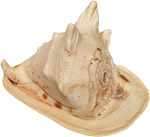
BLMH100
rare type |
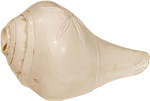
BLMH200
white, engraved |

BMLH300
white, dark patterns engraved |
| 
BLMH400
“Golden Victory”
richly decorated metal frame |

BLMH500
Vietnamese ritual horn |
Whoever has read or heard about the Indian National epic, the Mahabharata, has come in contact with the Conch quite often. For many thousands of years conches have been blown to announce the victory of the Good and Divine over evil. On the famous battlefield of Kurukshetra they sounded as a many-voiced choir that made the enemy tremble. Thus the Conch is an important, very sacred symbol of victory, and is still adored in India.
The Conch shell is cut at the top and blown like a trumpet with tightly pressed lips and high pressure. According to the size of the Conch it might be more or less difficult to produce a sound, but with patience and practice anyone can do it.
The white Conch presented here comes from India and is available in a smaller and larger version. The surface is engraved, which gives the instrument a very decorative look.
 |
Recorder

BLBF101
|

BLBF301
Moeck |
 
BLBF401
Schneider |

BLBF201
Adris Dream Flute |

School Recorder Soprano
“Flauto 1 Plus” |
BLBF101: available with German or baroque fingering, with or without double hole.
Moeck School Recorder Soprano: with German or baroque fingering.
The model made from light Maple wood has a pithy sound, whereas the model from dark Pear wood is more sonorous.
School Recorder Soprano “Flauto 1 plus”
Blue: Baroque fingering
Red: German fingering
This is the most popular school recorder for kids. The head is made from washable plastic. Beautiful timbre.
Adris Dream Flute: This beautiful flute is easy to blow, has a clear sound, and has a naturally attractive appearance. The flute is available with German or baroque fingering. You can choose from blue, red or natural wood.
Schneider Recorder: more pithy tone, German or baroque fingering; from cherry wood
 |
Shakuhachi

BLSH100
Rosewood
|

BLSH200
Bamboo root
|
BLSH110
Maple
|
BLSH120
Quince
|
The sound of the Shakuhachi is closely related to Zen-Buddhism. In Japan the bamboo flute became a tool of concentration to reach the meditative state of inner emptiness. This is what its music expresses: meditative vastness, flooded with silence and peace; long lasting sounds that calm the mind and lead to an inner depth.
Just to produce a single note is an art in itself and requires a calm devoted attitude. The use of the Shakuhachi leads to the qualities that one is looking for in Zen: poise, patience, devotion, concentration, inner silence and peace.
Originally the Shakuhachi was made only from selected roots of bamboo that had to have certain special qualities, only then were they used. Thus each piece was precious and unique. Also today the original instruments are built in the traditional way and cost accordingly. But meanwhile there are some simple types of fairly good quality that comply with the needs of a beginner. After all he has to find out first if he wants to dedicate himself to this mystic instrument. But those who lift the veil of its secret cannot escape the magic of the Shakuhachi so easily.
These are 2-part flutes.
 |
Bansoori
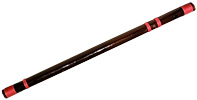
BLBA200
dark bamboo
|
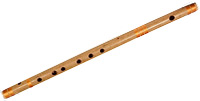
BLBA200
light bamboo
|
In India the Bansoori has been a mere folk instrument for a long time. Only with the dawn of the 20th century did it become a solo instrument of classical music, thanks to great musicians like Hariprasad Chaurasia.
The Bansoori is made of a long, quite thick bamboo cane, which produces very low notes due to its length. The holes are positioned quite far apart, a distance for most people almost impossible to cover. Only hard practice enables the player to stretch the fingers adequately in order to cover all the holes. Usually the Indians cover the holes with outstretched fingers instead of the fingertips which makes it easier to play. For Western people to play the Bansoori is definitely a challenge. But whoever can get the hang of it is rewarded with a warm, deep and typically Indian flute sound.
Bansooris are mostly tuned in D and E but are also available in other tunings and smaller sizes. These flutes are easier to play, but then of a higher pitch.
 |
Overtone Flute

BLOT100
bamboo, large
|

BLOT100
special wood
|

BLOT101
bamboo small
|

BLOT300
black plastic
|

BLOT400
Fairy Flute, glass
|

BLFU100
Fujara, ca. 90cm, elder wood
|

BLFU200
Fujara, ca. 150cm, elder wood
|
The Overtone Flute is a very old northern instrument whose special sound and range had a great influence on Folk music in many places.
The playing technique is based on a mathematical principle: if you blow less you get a low note; the stronger you blow the higher the notes are and the so-called scale of overtones or natural tones unfolds.
The Slovakian Fujara has as special place amongst the overtone flutes. Its length is about 150 centimeters. At the upper end a thin pipe of 40 centimeters length is fixed with leather stripes or twine. That is the mouthpiece. The body of the Fujara is handcarved from young elder wood and decorated with typical Slovakian ornaments. An amazing experience of sound…!
 |
Nagaswaram, Shenai, Bombard & Zurna

BLNA100
Indian Nagaswaram
|

BLSN100
Indian Shenai
|

BLSN100
Indian Shenai
|

BLSN200
Nepalese Shenai
|

BLFB100
French Bombard
|

BLAZ100
Armenian Zurna
|
Lovers of Indian classical music know that the nasal sound of Indian reed instruments is part and parcel of it. It is loud and penetrating, as these wind instruments are played mostly outside at ceremonies and processions. There they have to drown out the noise of the crowd.
The oboe-like Nagaswaram and Shenai are related to each other, though the first one is the elder sister. It has a length of 70 to 80 cm while the Shenai is much shorter at 25 to 35 cm. Both instruments have a conically shaped tube that leads to a flare. The flare of the Shenai is mostly made from metal. The reed that has to be soaked long enough before playing is put on top of the tube. High pressure is needed in order to produce a tone.
The Zurna, from Anatol, is also known as the Surnay, Surla or Zournas. It is described as a double reed wind instrument with a conical body. Its sound is loud and strong and it is played outside. The Zurna has a fixed place in the folk music of Turkey and neighbouring countries, but also used to be played in Ottoman military music.
Very similar in construction and sound is the Bombard, played in Breton and Cornwall. Unlike the other instruments of that category, it has keys. Due to the high pressure required, the Bombarde can be played only for a short period of time. That suits the Breton folk music perfectly where the Chorus and the Soloist alternate.
The Nagaswaram is mainly played at marriages and temple celebrations, together with the Indian drum called the Thavil. In the West it became known thanks to saxophonist Charlie Mariano.
Additional mouthpieces for all instruments are sold separately.
 |
Hu-Lu-Si

BLHU100
Top quality, decorated
|

BLHU200
Top quality, simple look
|
Sounds very Chinese, doesn’t it? Indeed, this kind of snake charmer comes from China. The unusal pear-like form attracts one´s attention. By blowing two metal plates that are inside the air room start vibrating. They produce the drones of the Hu-Lu-Si. Two tubes are directly connected with these metal plates, another one has holes and is played like a common flute.
The Hu-Lu-Si is of high quality and offers a clear sound. It looks very beautiful and is sold in a nice box.
 |
Kaval

BLKA100
special wood |
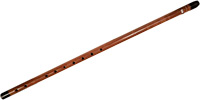
BLKA20
dark wood
|
In times gone by, when shepherds still lived with the sheep out in the fields, they often used to entertain themselves with home-made flutes, but also the animals listened to the sound of the instrument. The Kaval belongs to the category of those simple folksy wind instruments. Playing is a challenge though, as the Kaval is blown without any mouthpiece on the upper end of the tube, like the Turkish Ney.
Kavals are played in Armenia, Turkey, Bulgaria and a few other Eastern European nations. The construction and scale of the flutes differ, depending on the country. The narrow tube, between 30 and 80 cm, is often carved from plum, cherry or box wood. There are 7-8 playing holes and some additional holes for fine tuning. Nowadays the Kaval is also sold as an easy-to-play wooden overtone flute — similar to a recorder — providing a scale of overtones.
 |
Panpipes
According to a legend the Greek god Pan had fallen in love with a nymph who was frightened of him. She fled from him and was saved by a compassionate god who transformed her into reed. Pan cut a flute out of the reed and played on it to console himself. Thus Pan Pipes were born.
The oldest Pan Pipes were found in 3000-year-old tombs. They were made from bird bones of different lengths, bound together in a row by wax or resin. The way to blow the Pan Pipe is the same as blowing on bottles. There are no holes; each tube corresponds to one note.
There are round and straight models. Tuned pipes are in chromatic order. Here the halfnote is produced by changing the angle of the flute. A lot of practice is needed so that the fast move between the single tubes and the right angle becomes automatic.
 |
American-Indian Flute
A ritual wind instrument with a magical sound!
This flute is quite easy to play. It fascinates listeners with its glissandi which you can create by blowingharder or softer. Its high standard of handcraft and its simple tuning enable even the beginner to improvise easily. The American Indian Flute is tuned to 5 notes pentatonic minor. The advanced player can create a sixth note, thus playing on a diatonic scale. You may learn with the help of the table of chords included with the Flute.
 |
Schwegel
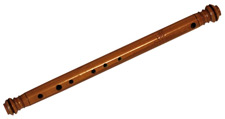
BLSW101
On request |
A Schwegel is a simple wooden 6-holed Fife. Another name for it is Seitlpfeife. It is a typical folk music instrument and has an age long tradition, especially in the Salzkammergut (Salzburg area) and Bavaria. They are always played in pairs.
The flute is usually tuned in A´, H´, C´ or D´´ but most commonly tuned in A´(440 Hz).
The pitch thus ranges from very low up to very high according to the construction. The scale has about 2.5 octaves.
 |
Duduk
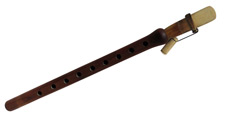
BLDD001
Armenia
incl. mouthpiece |
Thanks to the legendary Armenian Duduk player Djivan Gasparyan the Duduk - once an instrument for poor people - became popular not only in its own country but also on an international level. Its significance even grew to such a degree that UNESCO added it to the list of “Masterpieces of the immaterial heritage of mankind”.
The Duduk was already being played 5000 years ago in Mesopotamia, thus it is one of the oldest double reed instruments in the world. The tube made from apricot wood has 8 holes and 1-2 thumb holes on the back. The remarkable feature of the Duduk is the reed with a length of up to 14 cm, which gives the instrument its typical sound: melancholic, nasal, sonorous and meditative.
Due to the popularity of Djivan Gasparyan the sound of the Duduk made its way to different music styles. It was used for sound tracks and performed successfully in concerts with internationally renowned musicians like Sting, Andreas Vollenweider, Peter Gabriel. In that way the traditional instrument became widely accepted and loved beyond the boundaries of tradition.
 |
Xaphoon

BLXA001 Bamboo
BLXA002 Plastic |
Heard of it? A Sax made of bamboo!
And it’s not much bigger than a Recorder. At least it has the same tuning—C major.
But the playing is more demanding: the mouthpiece is similar to that of a Clarinet. The reed must be pressed tightly with lips and teeth and then you have to blow powerfully. Strengthens breathing and abdominal muscles!
The plastic model is cheap, split-resistant and easy to clean. The sound is stronger and more sonorous than with the bamboo Xaphoon. It sounds more like the original Saxophone.
About 35 centimetres long, playing chart included.
 |
Didgeridoo

BLDG110
Eucalyptus |

BLDG210
Bamboo |




BLDG310
Hemp Fibre |

BLDG510
Travel Didge |

ZUDH001 Didgeridoo Case
Normal and padded fabric cover |

Didgeridoo Wax
ZUDW001 Kneading Wax
ZUDW002 Original
|
Eucalyptus: This traditional ritual instrument of the Australian Aborigines has been very popular for many years. It is the outer expression of mysticism and of the close connection between native inhabitants and nature. Countless legends tell how the Didgeridoo was born. The raw material of this instrument is a branch from the Eucalyptus tree that is hollowed out by hungry termites (a special kind of ant). Afterwards they are crafted carefully with tools. Originally the didgeridoo was painted according to the event that it was used for; after the ceremony the paint was washed away. Nowadays the Didges offered for sale are very often decorated with artistic paintings. Thus each instrument is unique, not only in its natural form and material but also as a work of art.
Nevertheless, If you prefer the simple look, you can get a natural didge, too.
The sound of this ancient wind instrument differs according to the size, the wood (there are quite a few types of Eucalyptus) and the diameter of the tube. The variety of sound and rhythm is created by a combination of movements of mouth and tongue, breathing techniques, and voice effects. Many overnotes can be produced with practice. If you are looking for a sophisticated rich sound, choose an originally handmade Australian Didgeridoo from Eucalyptus wood.
Bamboo: In comparison to the original Didges this type is really cheap; beginners love to start with it. It is a bit hard to discriminate between the two types, as the Bamboo Didges are painted as beautifully as the Eucalyptus ones. They are lightweight and offer a rich sonorous sound. The disadvantage: the structure of Bamboo changes according to climate; it can split when it is too arid (as is the case with the European climate). Little splits can be repaired with beeswax or liquid wood glue.
Hemp: Didgeridoos made from Hempstone are nearly indestructable, show no leaks, need no wax for the mouthpiece and are easy to play. Not only the outer design can be created in manifold ways but also the sound, which is made according to acoustic requirements. Hempstone consists only of Hemp, water and non-toxic colours. Hemp is a pure natural material that grows in an ecological way. These fantastic didges come from an Austrian factory. They are a true and environmentally-friendly alternative to the traditional didges and fulfill even the high demands of professional musicians.
Travel Didge: The alternative for the enthusiastic player who cannot do without the Didge while travelling. It is short (about 50 centimeters), lightweight and solid. Its sound is surprisingly rich and earthy. The body is made from rare wood, the mouth piece from Pear wood.
Plastic/Slide Didge: The ideal instrument for beginners as it is blown very easily. The length of the tube is changeable, the lower end is flared.
 |
Bagpipes

BLDS10
Scottish
Rosewood |
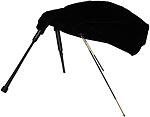
BLDS201
Practice Bagpipe
Plastic |

BLDS301
Practice Chanter
|
Bagpipes were invented about 4000 years ago in the Middle East. Probably they came to Europe with the Romans. Although we associate the remarkable sound of Bagpipes with Scotland or Ireland this instrument is also played traditionally in Eastern European areas such as Bohemia, Slovenia, Romania. According to the area the construction and sound vary.
Bagpipes, also called Dudelsack, belong to the family of reed instruments. They have one or more playing pipes and one or more drone pipes that produce a lasting tone. A tight air bag of leather or synthetic material supplies all the pipes with air. The player blows it up with the help of a blowing pipe or bellows. The supply of air in the bag enables the sound to last independently from the player’s breathing.
We offer practice chanters as well as the original Highland pipes from Scotland. On request, German and Austrian types are available too. As beginners' instruments we sell different kinds of practice chanters, also known by the name Bombarde or Rauschpfeife.
 |
Tin Whistle









BLTW101: Generation Flageolet Whistle, 6 scales, nickel and brass
BLTW102: Waltons Tin Whistle D, with finger chart
BLTW103: Set: Waltons Tin Whistle D, with CD and instruction booklet
BLTW104: Feadog Messing D, high quality
BLTW105: Feadog Pro D, high quality
BLLW101: Kerry Low Whistle D, black plastic mouthpiece
BLLW102: Chieftain Low Whistle, two-part, tunable
BLLW103: Howard Low Whistle, nickel or black, tunable
|
The Tin Whistle is the wind instrument heard typically in Irish folk music. Originally made from tin, nowadays it is made from different materials like plastic, nickel and others.
The flute has 6 holes on the front side (no thumb hole) und is characterized by a pure high sound. By overblowing one plays the upper octave.
Like the standard Tin Whistle with a high pitch, the low whistle is an instrument used commonly in Irish folk music. Its sound is low and sonorous.
Tin Whistle: Generation, Clarke, Susato, Dixon, Chieftain
Low Whistle: Kerry, Chieftain, Dixon, Howard
 |
Trumpet
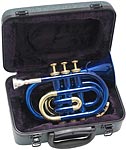
BLTM310
Bb-Pocket Trumpet |
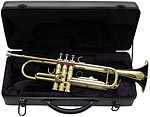
BLTM320
Bb-Trumpet |
The Trumpets we offer here are made by the German factory GEWA. There are standard and piccolo models.
Incl. bag
 |
Mouth Organ

BLMH110
Hohner Blues Harp MS |

BLMH120
Hohner Echo SuperVamper |
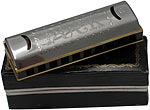
BLMH130
Hohner Puck |

BLMH140
Hohner Weekender tremolo |

BLMH205
Victory Standard 10 hole |

BLMH215
Victory Tremolo 24 hole |

BLMH220
Victory Tremolo
C-G 24 hole |

BLMH225
Victory Chromatic |
This popular pocket instrument has a history of 150 years. The mouth organ is easy for anyone to handle. Certainly that is the reason why it has become an established folk instrument worldwide. Simple melodies are easy to learn, but the scales and accords depend on the type of instrument.
Here you find a collection of standard instruments made by Victory and Hohner.
 |
Nose Flute
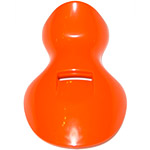
BLNF110
Nose Flute Pro, especially easy to use
|

BLNF220
large |

BLNF210
small |
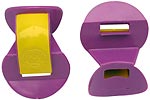
BLNF100 |

BLNF203
African Hardwood |
Believe it or not, this flute is blown with the nose!
Place the opening at the thicker end of the flute against the nostrils; the open mouth is placed around the other hole. The flute has to be pressed against nose and lips. Then blow gently through the nose. The mouth creates a resonating chamber where the sound is formed, and which can be varied by moving the cheeks and tongue. You can thus create funny sounds and even simple melodies. You just have to imagine the melody and automatically the mouth finds the right way to form it.
Real fun and it fits in any pocket!
Plastic Nose Flute: These models are cheap and easy to clean with water—the ideal type for kids or larger groups.
Austrian Nose Flute: This model is precisely carved (especially the labium) and thus produces a clear sound similar to that of a recorder. You can blow precise notes, so it can be used as an adequate musical instrument in classical and folk music. The instrument maker uses different kinds of wood even for one flute to give each flute a character of its own. The different sizes correspond to individual noses.
Fabric bag included.
African & Indian Hardwood Nose Flute: These models are carved in a nice way and are comfortable to play. They can be treated with flute oil. The African Nose Flute is very similar to the Indian type but has a larger range. It is made with great care. As all Flutes are carved by hand, so each one has its own individual sound.
 |
Cuckoo Flute

BLKF101
Cuckoo Bamboo |
This is a solid simple Flute for kids, made from Bamboo. There is only one hole on the back. Blow the Flute and alternately open and close the hole: cuckoo, cuckoo!
Suitable for age 3+.
 |
Lotus Flute

BLLF100 Bamboo
BLLF200 Plastic
BLLF300 Metal |

Aluminium with wooden plunger
BLLF400 19cm
BLLF401 28cm |
No Vietnamese celebration would be complete without the chirping of simple little Lotus Flutes. But in the West the Lotus flute enjoys great popularity, too. Children love it as well as adults.
While blowing you move the plunger up and down and create a smooth and infinitely variable scale. Both models in metal or plastic allow a wide range of notes and glissandi. Try and enjoy!
Solid and long-lasting.
Bamboo: Makes your child chirp like a little bird! Cheerful sound and easy to play. Suitable for age 3+.
 |
Kazoo

BLKZ101
Wooden |
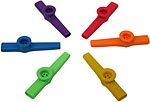
BLKZ202
Coloured Plastic |

BLKZ201
Plastic |

BLKZ301
Metal |

BLKZ401
Mirliton |
The Kazoo is a simple musical instrument that everyone can play. You will not get far by just blowing in. If you sing into the wider opening your own voice causes a vellum membrane to vibrate. It produces a saxophone like sound like when blowing on a comb. The outcome solely depends on what you put in.
The Kazoo originates from the Mirliton, a traditional African instrument. In the Middle Ages the Mirliton was used too, but then had a totally different form. Our photo shows this old type: it is made from clay, consists of 2 pieces and can have a length of 27cm. The upper part has many holes (to make the sound) and a hole at the side serves as a mouthpiece. The Mirliton resembles an ocarina.
The sound quality varies according to the material. The most common and the cheapest one is plastic, which amplifies the squeaky sound. Kazoos from metal sound lighter and are more stable, but more expensive too. Kazoos from wood are more beautiful and offer a warm soft sound.
It is an ideal instrument for groups of kids and offers activity for their spare time. Maybe you could form a Kazoo choir, to create harmonious play among young musicians. Easy handling and a lot of fun are guaranteed. Just take care of the membrane as that affects the quality of sound, but many types of Kazoo allow the replacement of damaged membranes.
 |
Ocarina


Tierform:
BLOD401 4-Hole Dolphin small
BLOD402 4-Hole Dolphin large
BLOK401 4-Hole Turtle small
BLOK701 7-Hole Turtle large
BLOV401 4-Hole Bird small
BLOV701 7-Hole Bird large |

BLOR401 4-Hole Runes
BLOR701 7-Hole Runes |
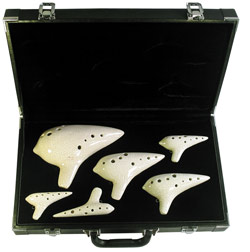
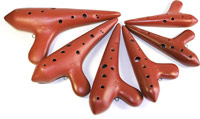

Austrian
BLOK701: Soprano, C and G
BLOK702: Alto, C, different colours
BLOK703: Piccolo to Bass, C and G, set of 6 white ocarinas in black case
|
The Ocarina (Italian for “little goose”) is a wind instrument from baked or dried clay. It was used by the ancient highly developed cultures such as the Mayas, Incas and Aztecs. Nowadays the Ocarina is famous thanks to the computer game, The Legend of Zelda. There the hero transports himself to different places by playing an Ocarina.
The Ocarina is held with both hands. It has at least four holes, and sometimes up to twelve. Thus you can play on simple diatonic scales with or without half-notes.
Our blue models are by John Langley, and are some of the best Ocarinas. There are simple diatonic tunings for one or two parts (duets). Other types are Sopran, Sopranino and Alto in pentatonic tuning.
Each instrument is handmade from ceramic. For children we recommend the plastic models as they have a long life and are easy to clean.
We also offer Ocarinas from Austria, Italy (mostly the ancient type) and from South America.
Animal & Rune Types: These nice looking colourful Ocarinas originate from an Austrian workshop. There are various types and sizes with 4 or 7 holes. Along with each Ocarina you get a little song booklet free.
Concert Ocarina: This model from Italy or Austria has 10 holes and is tuned exactly to a diatonic scale. You can choose coloured or natural (terracotta) type.
 |
Kids’ Flute
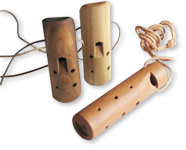
BLKF100 pentatonic
BLKF200 diatonic
|
A flute for children has to be solid and suitable for small fingers. Plus it should be made from a natural material and pleasant for the ear, especially that of adults.
These children´s flutes made by workshops in Leipzig, Germany, and in Hungary fulfil all those demands. They have a simple but appealing design and are inexpensive. The flutes are about 10cm long and have a leather strap to hang around the neck. They are tuned either pentatonic or diatonic and offer a very pure sound. The recorder need not be the first instrument to allow a kid to discover the music world.
They give joy to young and old, as they can be taken easily on walks and journeys.
 |
Howling Tube

PEHR100 |
It´s not only fun for kids! The Howling Tube also offers sophisticated effects while improvising or in group work.
These plastic tubes with Accordion-like structure are very easy to play:
Hold one end of the tube tightly with one hand and start spinning it around. By changing the speed of spinning you can create lower and higher notes according to the natural scale. You may also use 2 Howling Tubes at once, so as to play in two different scales. The best way to do that is to cut off a few inches of one tube.
 |
Bird Whistles
With the help of these bird voices you can imitate the birds almost perfectly. Maybe you will be able to talk to them!
Both brands offer many more bird voices which cannot be listed here. If you are looking for something special we are happy to help you. Also we would like to point out that the French company wants the use of his whistles only for better understanding of the birds. Please be aware not to disturb the birds in their habitat. Of course the bird voices are not made for hunting.
 |
Elephant

PEEF300 large
PEEF200 medium
PEEF100 small
|
A lovely trio of elefants which offer a sound when you blow on them.
Sold separately.
 |
Owl

PEEU100 EU-1
PEEU200 EU-2
PEEU300 EU-3
PEEU400 EU-4
|
Decorative wooden figures blown in the same way as the elephants, with a natural owl sound.
Owl family in 4 sizes, sold separately.
(Not to be used for owl mails)
 |
Wind Pipe

BLWF300 | 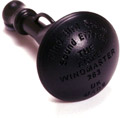
BLWF400
Acme plastic |
An instrument with great effects for radio plays, theatre or simply as a joke.
 |
Mouth Pieces

Bombard Mouthpiece
ZUBM001
GR 2681 |

Duduk Mouthpiece
ZUDM001
|
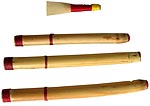
Bagpipe Reed
ZUDR001 Drone
ZUDR002 Chanter |

Practice Chanter Mouthpiece
ZUPM001
Kunststoff |

Saxophone Reed
ZUPM001
740 384 |

Shakuhachi Mouthpiece
ZUSM001
|
 |
|
Copyright © Gandharva Loka |

